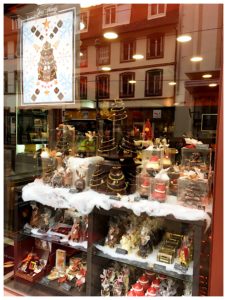31 January 2017
I spent the past weekend in the sweltering summer heat, in the capital of the Sunshine State of Australia. Also known as Brisbane, Bris-Vegas and Brissy to locals, the summer temperatures here average in the high 20s to early 30s degrees Celcius – essentially, the melting point of chocolate. Can chocolates still be enjoyed under these conditions and if so, where?
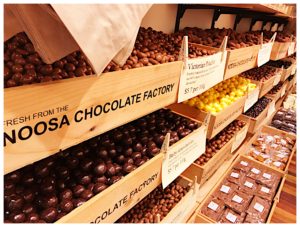 Noosa Chocolate Factory is the homegrown favourite of many. Here, you can pick and mix as much or as little to your hearts content, and sample along the way. Established just over a decade ago, Noosa Chocolate Factory started out as a contract manufacturing business, eventually finding its niche and going direct to consumer with chocolate-enrobed, Australian-grown nuts, berries and fruits, as well as nut brittles.
Noosa Chocolate Factory is the homegrown favourite of many. Here, you can pick and mix as much or as little to your hearts content, and sample along the way. Established just over a decade ago, Noosa Chocolate Factory started out as a contract manufacturing business, eventually finding its niche and going direct to consumer with chocolate-enrobed, Australian-grown nuts, berries and fruits, as well as nut brittles.
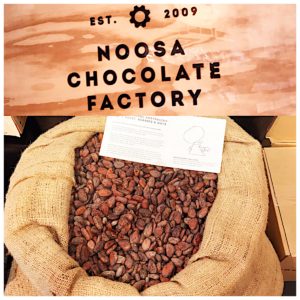 The chocolate is made bean to bar from cacao beans sourced directly from farmers in Papua New Guinea and available as 77% dark, 40% milk and 37% white cacao chocolate. The added attraction is the freshness of the chocolates – apparently “made from scratch in the last 72 hours” in their factory in Noosa. My top seasonal picks are the chocolate baby strawberries (they’re actually not that small!), chocolate cherries and the Bowen mango macadamia.
The chocolate is made bean to bar from cacao beans sourced directly from farmers in Papua New Guinea and available as 77% dark, 40% milk and 37% white cacao chocolate. The added attraction is the freshness of the chocolates – apparently “made from scratch in the last 72 hours” in their factory in Noosa. My top seasonal picks are the chocolate baby strawberries (they’re actually not that small!), chocolate cherries and the Bowen mango macadamia.
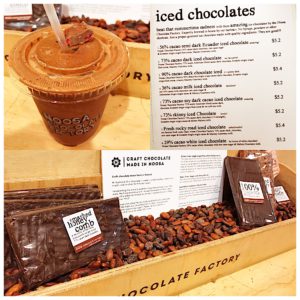 If you drop by their cafe and retail outlet, “The Dark Chocolatier”, just five doors down from their flagship store, do try their hot or iced chocolates. I had the 73% dark cacao skinny iced chocolate and it was delish!
If you drop by their cafe and retail outlet, “The Dark Chocolatier”, just five doors down from their flagship store, do try their hot or iced chocolates. I had the 73% dark cacao skinny iced chocolate and it was delish!
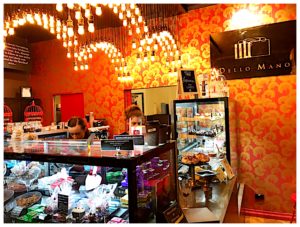 Brownies are brownies…..until you sink your teeth into Dello Mano‘s brownies. These are something else. Born out of passion by the husband and wife team of Deb and Bien, the Dello Mano brownies are lovingly handcrafted with the finest ingredients, right down to the Belgian chocolate made from Ghanaian cacao beans. The jewel-like squares of brownies, wrapped in brightly coloured foil, are almost too pretty to eat.
Brownies are brownies…..until you sink your teeth into Dello Mano‘s brownies. These are something else. Born out of passion by the husband and wife team of Deb and Bien, the Dello Mano brownies are lovingly handcrafted with the finest ingredients, right down to the Belgian chocolate made from Ghanaian cacao beans. The jewel-like squares of brownies, wrapped in brightly coloured foil, are almost too pretty to eat.
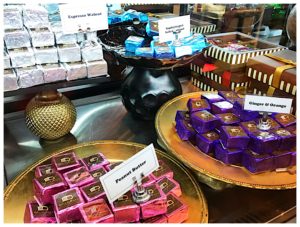 Phoebe, the owner’s daughter, tells me that the Luxury Classic is the original flavour and their most popular, and offers me a sample. It’s decadent, rich, chocolatey and very moorish. I can definitely appreciate its appeal and end up with several brownies to take home with me, based on Phoebe’s recommendation. Aside from the brownies, Dello Mano also creates a tantalising array of cakes and biscuits to satisfy many a sweet tooth.
Phoebe, the owner’s daughter, tells me that the Luxury Classic is the original flavour and their most popular, and offers me a sample. It’s decadent, rich, chocolatey and very moorish. I can definitely appreciate its appeal and end up with several brownies to take home with me, based on Phoebe’s recommendation. Aside from the brownies, Dello Mano also creates a tantalising array of cakes and biscuits to satisfy many a sweet tooth.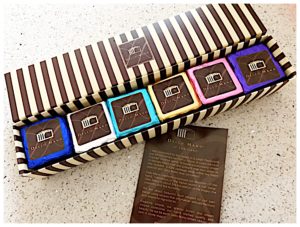
A personal favourite of mine is Murielle Vuilleumier Swiss Chocolatier. Here, I am assured of a feast, not just for my belly but also my eyes. Murielle never fails to amaze with her luxurious, artisanal selection of ganaches, pralines and truffles. They are works of art to be admired – vibrant, colourful, and perfectly tempered and shaped.
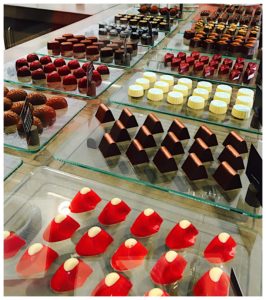 Murielle takes inspiration from several sources in creating her flavours, including her Swiss heritage (The Matterhorn) and suggestions/ requests by her regular clientele (Alexandria’s Mint).
Murielle takes inspiration from several sources in creating her flavours, including her Swiss heritage (The Matterhorn) and suggestions/ requests by her regular clientele (Alexandria’s Mint).
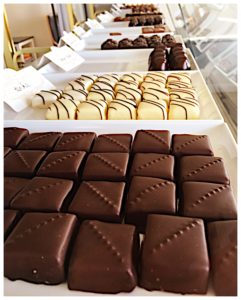 Another destination worthy of a mention is Couverture & Co. Chocolatier and owner Jessica handcrafts a selection of generous, larger than bite-sized ganaches and truffles in the kitchen at the back of the shop. Here, you can sample traditional favourites like the dark chocolate ganache and peppermint cream, as well as more adventurous flavours like Milo, Banoffee and Blackforest.
Another destination worthy of a mention is Couverture & Co. Chocolatier and owner Jessica handcrafts a selection of generous, larger than bite-sized ganaches and truffles in the kitchen at the back of the shop. Here, you can sample traditional favourites like the dark chocolate ganache and peppermint cream, as well as more adventurous flavours like Milo, Banoffee and Blackforest.
I conclude that, thanks to the advent of the humble air conditioner, chocolates can certainly be enjoyed in the Sunshine State. In fact, despite the unfavourable summer conditions, one should not be too quick to discount Brisbane as a chocolate destination. Otherwise, as I’ve discovered, you’ll miss out on some worthy, homegrown chocolate experiences here!
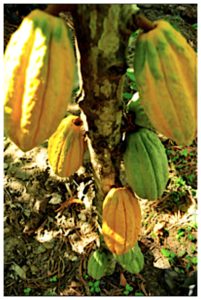 The
The 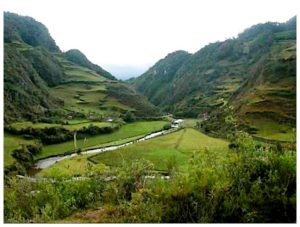 Re-discovered in the Maranon Canyon in Peru less than 10 years ago, the Fortunato No. 4 derives its name from the owner of the property from which the “mother tree” was found – Don Fortunato and the number of the sample tested and verified by the United States Department of Agriculture (USDA) to be genetically Pure Nacional cacao.
Re-discovered in the Maranon Canyon in Peru less than 10 years ago, the Fortunato No. 4 derives its name from the owner of the property from which the “mother tree” was found – Don Fortunato and the number of the sample tested and verified by the United States Department of Agriculture (USDA) to be genetically Pure Nacional cacao.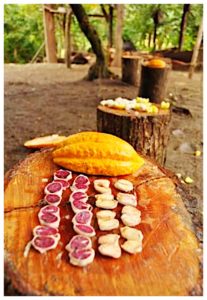 The Pure Nacional cacao yields a unique mixture of white and pale purple beans, generally in a 40:60 ratio. This is as opposed to the other varieties that typically produce either 100% of white or pale purple beans. This unique mixture is thought to contribute to the exquisite aromas and flavours of the resultant chocolate.
The Pure Nacional cacao yields a unique mixture of white and pale purple beans, generally in a 40:60 ratio. This is as opposed to the other varieties that typically produce either 100% of white or pale purple beans. This unique mixture is thought to contribute to the exquisite aromas and flavours of the resultant chocolate.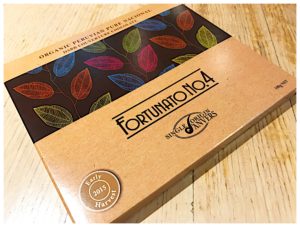 I recently purchased a bar of the
I recently purchased a bar of the 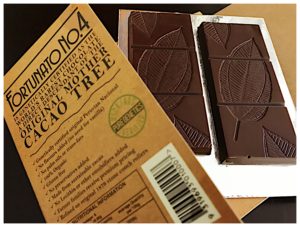 The packaging has earthy tones, reflective of the habitat of the cacao, and colourful motifs resembling leaves of the cacao trees but also the pods. Simple but meaningful. There are two small bars per pack, vacuum sealed in a separate inner packaging.
The packaging has earthy tones, reflective of the habitat of the cacao, and colourful motifs resembling leaves of the cacao trees but also the pods. Simple but meaningful. There are two small bars per pack, vacuum sealed in a separate inner packaging.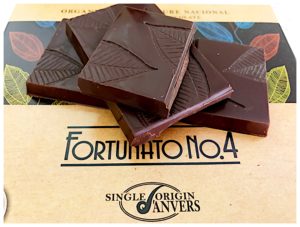 As soon as I tear open the inner packaging, I am immediately greeted by the inviting aroma of fruits, reminiscent of ripe plums. I break off a piece; the chocolate has a good snap. The initial flavours are intensely fruity, like a medley of sweet stone fruits with hints of lychee. This is followed by lengthy notes of toastiness, think roasted cashews. There is an ever so slight bitterness on the tongue as the chocolate melts, which lingers after all the chocolate has disappeared. My palate is left fresh, despite this.
As soon as I tear open the inner packaging, I am immediately greeted by the inviting aroma of fruits, reminiscent of ripe plums. I break off a piece; the chocolate has a good snap. The initial flavours are intensely fruity, like a medley of sweet stone fruits with hints of lychee. This is followed by lengthy notes of toastiness, think roasted cashews. There is an ever so slight bitterness on the tongue as the chocolate melts, which lingers after all the chocolate has disappeared. My palate is left fresh, despite this.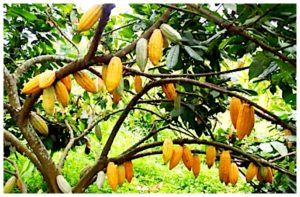 “The Project”, as Jan calls it, is his work in Latin America where he focuses on sourcing unique and rare cacao beans, and works with the farmers who cultivate, harvest and ferment these beans, either in small groups or cooperatives. It’s not just about the chocolate. For Jan and the company that he represents,
“The Project”, as Jan calls it, is his work in Latin America where he focuses on sourcing unique and rare cacao beans, and works with the farmers who cultivate, harvest and ferment these beans, either in small groups or cooperatives. It’s not just about the chocolate. For Jan and the company that he represents, 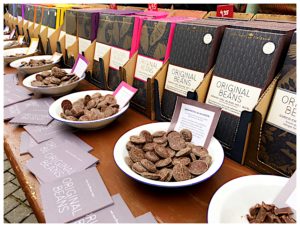 Through
Through 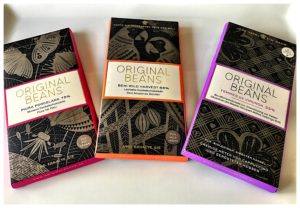 Now, let’s steer back towards the more familiar end of the value chain, to the beans and chocolates. How do they actually taste? I had the opportunity to sample the entire range at ChocolART and purchased 3 to savour at my leisure – the Piura Porcelana Peru 75%, Beni Wild Harvest Bolivia 66% and Femmes De Virunga Congo 55%.
Now, let’s steer back towards the more familiar end of the value chain, to the beans and chocolates. How do they actually taste? I had the opportunity to sample the entire range at ChocolART and purchased 3 to savour at my leisure – the Piura Porcelana Peru 75%, Beni Wild Harvest Bolivia 66% and Femmes De Virunga Congo 55%.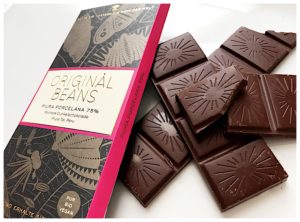 This bar has rich fruity aromas of berries, and a slight hint of earthiness. The chocolate is well tempered, as evidenced by the characteristic snap. The initial flavour is that of citrus peel, slightly acidic but refreshing. This gives way to the flavours of sweet berries and fleeting notes of prunes. The chocolate leaves a tad of acidity on my tongue. It’s a pretty good bar of chocolate with lots of fruity flavours – just as I’d expect in a Porcelana.
This bar has rich fruity aromas of berries, and a slight hint of earthiness. The chocolate is well tempered, as evidenced by the characteristic snap. The initial flavour is that of citrus peel, slightly acidic but refreshing. This gives way to the flavours of sweet berries and fleeting notes of prunes. The chocolate leaves a tad of acidity on my tongue. It’s a pretty good bar of chocolate with lots of fruity flavours – just as I’d expect in a Porcelana. This bar has the aroma of mushrooms and a scent that closely resembles Manuka honey. The chocolate is well tempered. The initial flavour is of mild mushrooms but this opens up to reveal lengthy notes of sweet fruits and hints of hazelnuts. The finish is subtle – I can just detect notes of roasted tea leaves. Once all the chocolate has melted, my mouth is left fresh. Such complex aromas and flavours in a chocolate – I’m surprised to have enjoyed this more than the Piura Porcelana!
This bar has the aroma of mushrooms and a scent that closely resembles Manuka honey. The chocolate is well tempered. The initial flavour is of mild mushrooms but this opens up to reveal lengthy notes of sweet fruits and hints of hazelnuts. The finish is subtle – I can just detect notes of roasted tea leaves. Once all the chocolate has melted, my mouth is left fresh. Such complex aromas and flavours in a chocolate – I’m surprised to have enjoyed this more than the Piura Porcelana!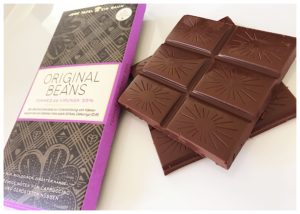 The aroma is toasty, nutty and slight earthy. The colour of the chocolate is a cross betweeen milk and dark chocolate, the result of the high cocoa content of this milk chocolate bar. The tempering is adequate, as evidenced by the sheen on the surface and the slight snap of the chocolate. As the chocolate melts in my mouth, the texture is creamy and smooth. The flavour is distinctly nutty, with hints of caramel. I can also detect subtle notes of roasted coffee beans at the end. Once all the chocolate has melted, it leaves a very mild bitter aftertaste in my mouth. The flavours are bold and interesting, as far as milk chocolate goes. If only all milk chocolates tasted this way….
The aroma is toasty, nutty and slight earthy. The colour of the chocolate is a cross betweeen milk and dark chocolate, the result of the high cocoa content of this milk chocolate bar. The tempering is adequate, as evidenced by the sheen on the surface and the slight snap of the chocolate. As the chocolate melts in my mouth, the texture is creamy and smooth. The flavour is distinctly nutty, with hints of caramel. I can also detect subtle notes of roasted coffee beans at the end. Once all the chocolate has melted, it leaves a very mild bitter aftertaste in my mouth. The flavours are bold and interesting, as far as milk chocolate goes. If only all milk chocolates tasted this way….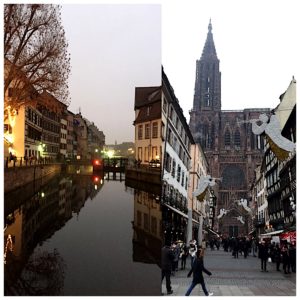 A city with meandering cobblestone streets lined with charming medieval timber-framed houses, each with a bilingual street name. A river encircling the Old Town that separates the old from new and runs into canals around the city, creating the most picturesque photography backdrop. And as Christmas approaches each year, a transformation into an enchanting winter wonderland complete with themed fairy lights, intricate decorations adorning medieval houses, a giant Christmas tree and the most amazing Christmas markets.
A city with meandering cobblestone streets lined with charming medieval timber-framed houses, each with a bilingual street name. A river encircling the Old Town that separates the old from new and runs into canals around the city, creating the most picturesque photography backdrop. And as Christmas approaches each year, a transformation into an enchanting winter wonderland complete with themed fairy lights, intricate decorations adorning medieval houses, a giant Christmas tree and the most amazing Christmas markets.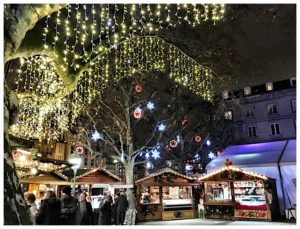
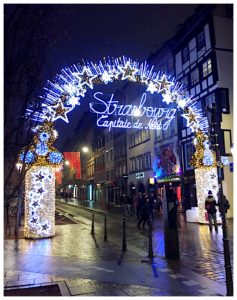
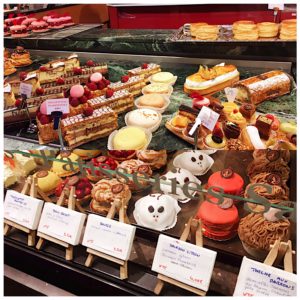 Thanks to my colleague and Strasbourg native, Fred, hubby and I were well equipped for our gastronomic discovery of the many sweet and savoury delights on offer, chocolates included.
Thanks to my colleague and Strasbourg native, Fred, hubby and I were well equipped for our gastronomic discovery of the many sweet and savoury delights on offer, chocolates included.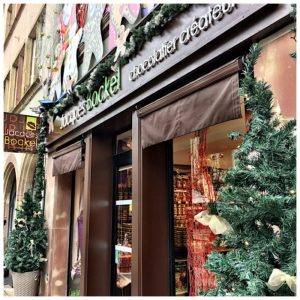
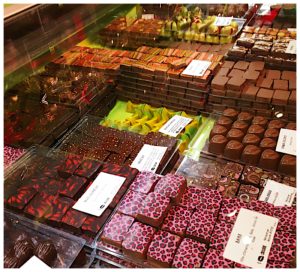 Here, you will find the cutest Christmas les maenneles. These are chocolate man-shaped miniature figurines,
Here, you will find the cutest Christmas les maenneles. These are chocolate man-shaped miniature figurines, 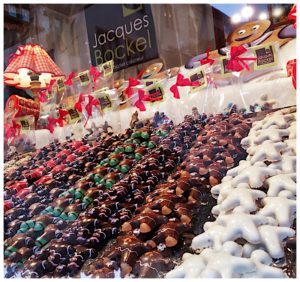 Don’t forget the Nut Alsace spread while you’re here. It’s a hazelnut chocolate spread in 4 flavours – think Nutella, only tastier. Ask for a tasting, straight from the fountain, and you will not be disappointed.
Don’t forget the Nut Alsace spread while you’re here. It’s a hazelnut chocolate spread in 4 flavours – think Nutella, only tastier. Ask for a tasting, straight from the fountain, and you will not be disappointed.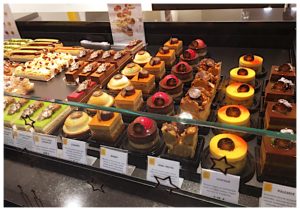
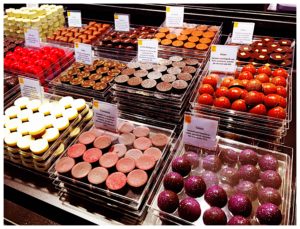 Hazelnuts and almonds feature heavily in the bon bons, but there are also unique flavours like bergamot and exotic fruits, all coated in 70% Venezuelan dark chocolate, 40% milk chocolate or white chocolate.
Hazelnuts and almonds feature heavily in the bon bons, but there are also unique flavours like bergamot and exotic fruits, all coated in 70% Venezuelan dark chocolate, 40% milk chocolate or white chocolate.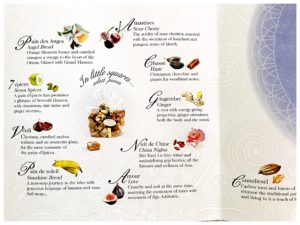 Head to
Head to 